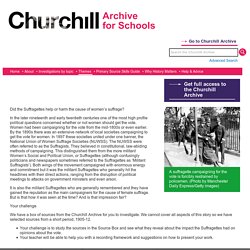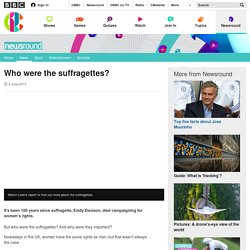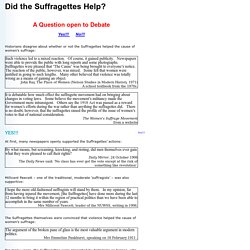

Did the Suffragettes help or harm the cause of women’s suffrage? We use cookies, just to track visits to our website, we store no personal details.

ACCEPT COOKIES What are cookies? Get full access to the Churchill Archive. Homework: Who were the suffragettes? CBBC Newsround. It's been 100 years since suffragette, Emily Davison, died campaigning for women's rights.

But who were the suffragettes? And why were they important? Nowadays in the UK, women have the same rights as men, but that wasn't always the case. In the early 20th century women didn't have the same rights as men - they couldn't vote in elections and the vast majority could only get jobs as house servants. The battle for equality lasted a long time - today marks the 100th anniversary of one of the most important days in that fight.
What happened to Emily Davison? On 4 June 1913, in front a crowd of around 300 thousand - one of Britain's most famous horse races came to an end. A women's right protester, called Emily Wilding Davison, had run out onto the track in the path of the horses. She was knocked down and later died in hospital. Homework: Click on this link to access the homework form. How to login to Google Classroom. The Suffragists - a good place to start. Suffragists - a good website with lots of pictures and information about the NUWSS. Explore a new resource that looks at the campaigning techniques of the suffragists and suffragettes.

The Suffragists In 1866, a group of women organised a petition that demanded that women should have the same political rights as men. The women took their petition to Henry Fawcett and John Stuart Mill, two MPs who supported universal suffrage. Mill added an amendment to the Reform Act that would give women the same political rights as men. The amendment was defeated by 196 votes to 73. In the wake of this defeat the London Society for Women's Suffrage was formed. The NUWSS adopted a peaceful and non-confrontational approach. Steps towards equal rights came with the Married Woman's Property Acts of 1870, 1882, and 1884 (amended again in 1925). The denial of equal voting rights for women was supported by Queen Victoria who, in 1870 wrote, 'Let women be what God intended, a helpmate for man, but with totally different duties and vocations'.
What does this Tree Mean? Votes and Wages. Early suffragist campaigning - good information on HOW they campaigned. Some working class men could vote During the 19th century, the franchise was extended to include more men both in the Second Reform Act 1867 and the Third Reform Act 1884.

Approximately 58% of the adult male population was able to vote by 1900. This included some working class men. Who were the Suffragettes. In 1867 the Reform Act extended the right to vote to many men who had previously not had this right.

John Stuart Mill proposed that the right to vote should be extended to some women, but he was not successful in persuading his fellow MPs to include this in the Act. Millicent Fawcett tried to get the vote through peaceful means such as meetings, petitions and leafleting but despite attracting many supporters her campaign achieved little. Emmeline Pankhurst realised that a more active approach was needed to win women the vote. Women deliberately broke the law to gain publicity. They disrupted meetings, chained themselves to the railings of Buckingham Palace, smashed windows and set post boxes alight. Women who were arrested wanted to be treated as political prisoners rather than as criminals. BBC Bitesize - Militant methods used by the suffragettes. 10 surprising facts about the Suffragettes.
But how much do we really know about the Suffragettes?

Here, Dr Jacqui Turner from the University of Reading reveals some lesser-known facts about the political movement… 1) Women did not get the vote on the same terms as men in 1918 Many people assume that, as a direct result of women’s war work during the First World War, they were given the vote on equal terms to men. However, they were not. Website for Stage 2 of the assignment - John D Clare Did the Suffragettes help women's suffrage? It can and has been argued that the Suffragettes damaged the cause of women’s suffrage.

A famous Shepherd cartoon in Punch shows a wild, half-mad woman (stereotyping a Suffragette) screaming at a well-dressed, respectable women, who is replying: ‘Help our cause? You’re its worst enemy!’ Certainly, many people at the time agreed that the Suffragettes harmed the women’s cause: The action of the Militants is ruinous. The feeling amongst sympathisers of the cause in the House [of Commons] is one of panic.
Letter from Lloyd George to CP Scott, . Lloyd George was, generally, a supporter of women’s suffrage but, over breakfast a couple of days later, he confided to Scott that talking to Christabel Pankhurst was ‘like going to a lunatic asylum and talking to a man who thinks he is God’.